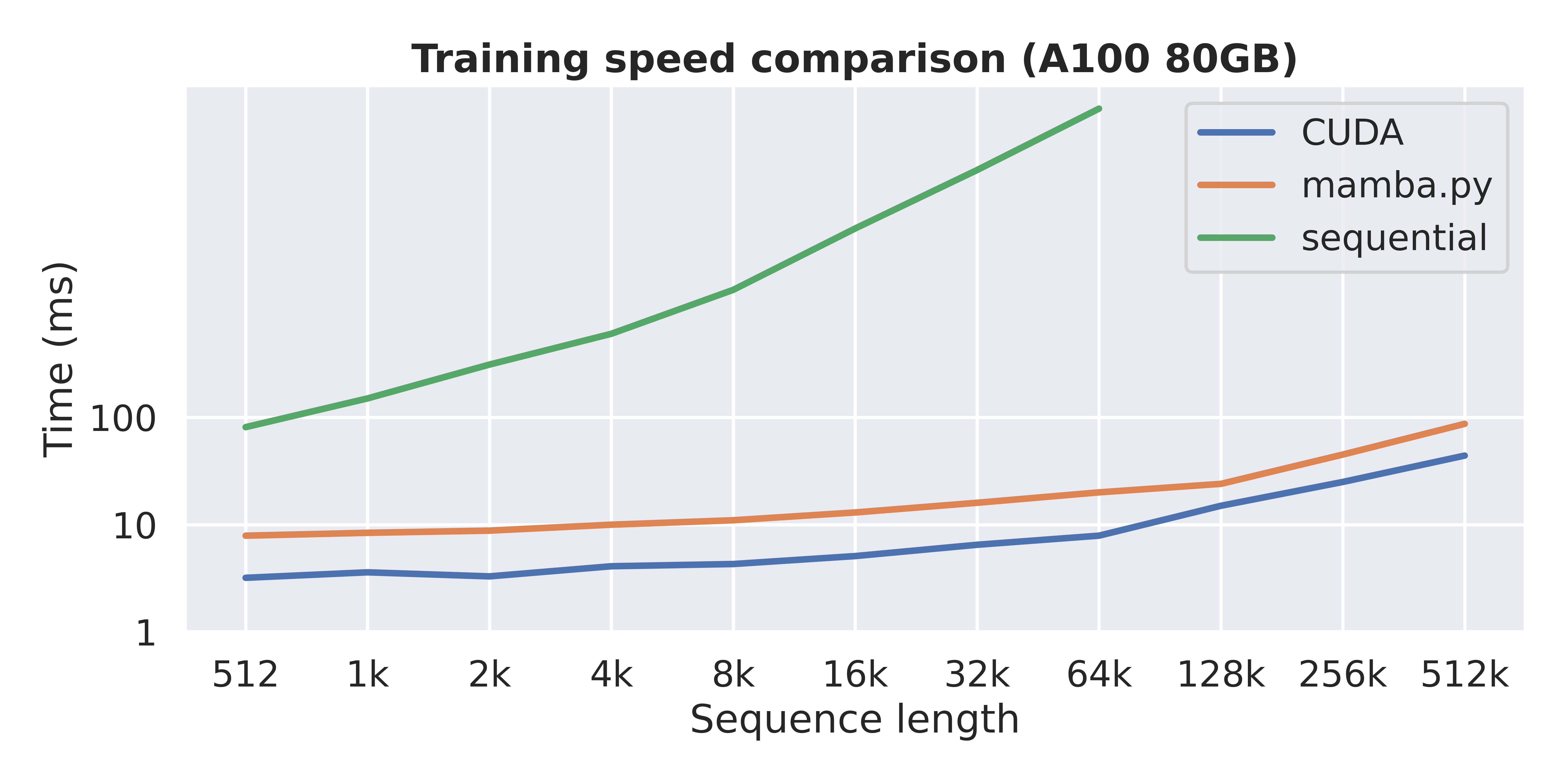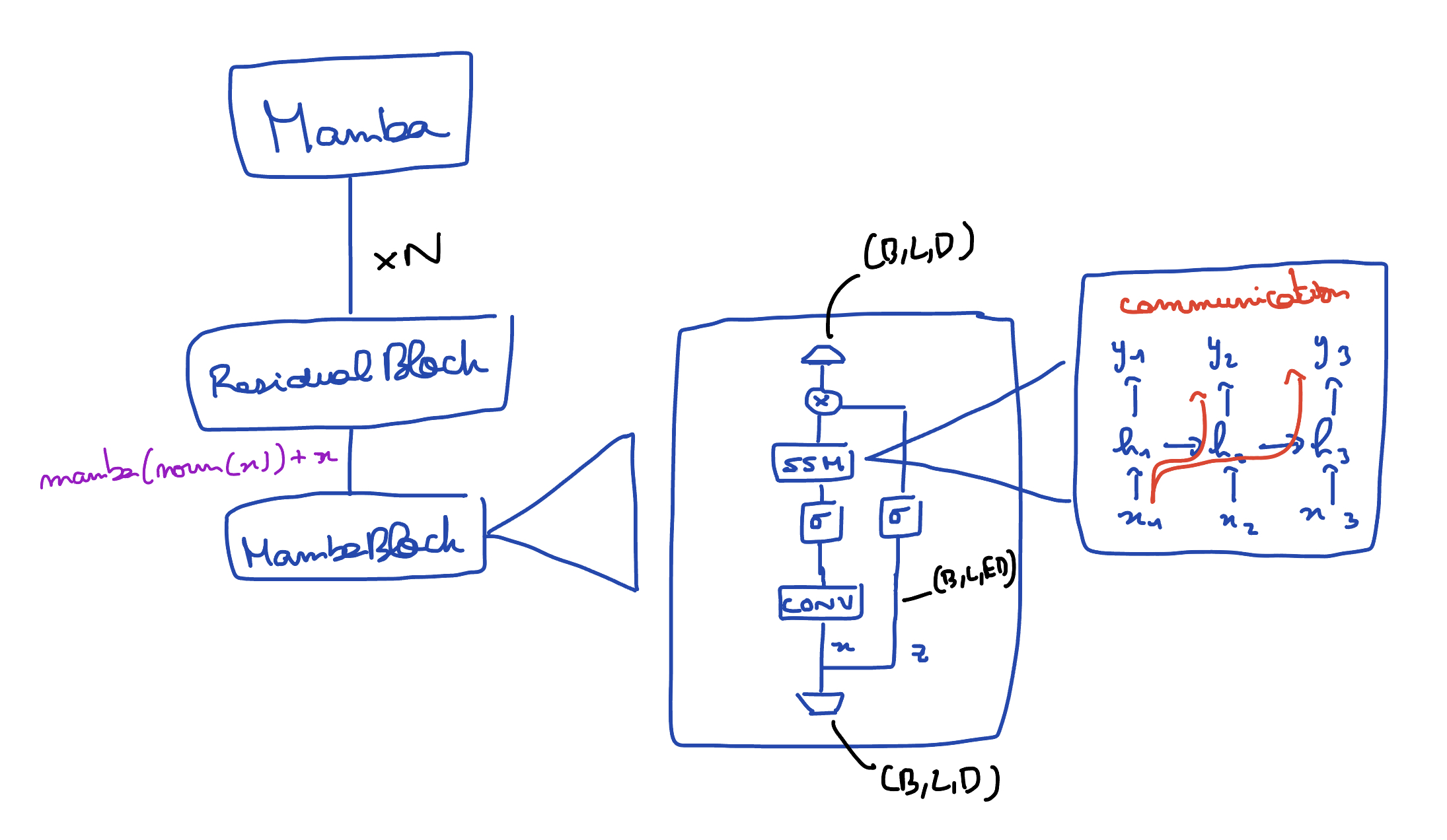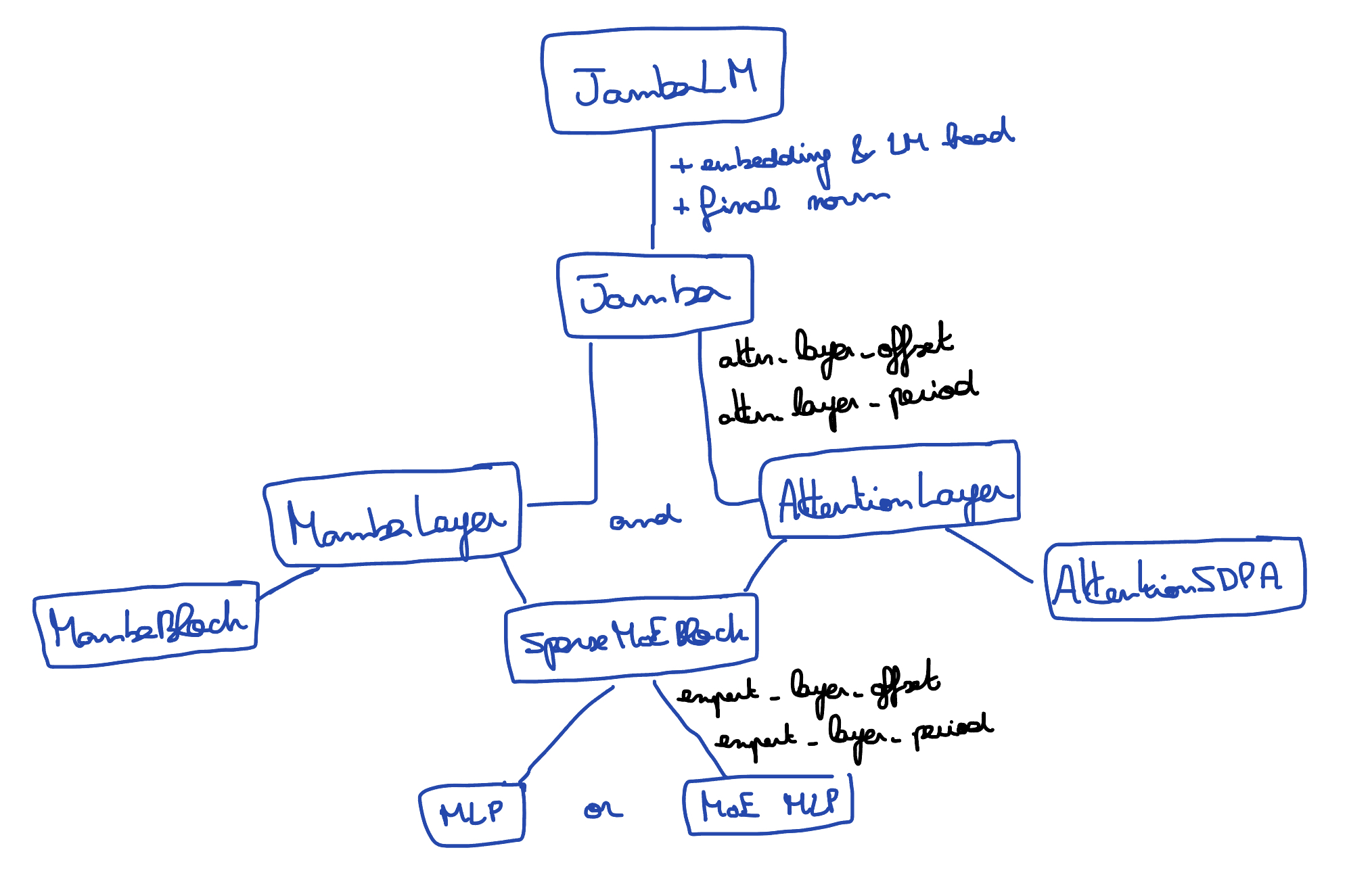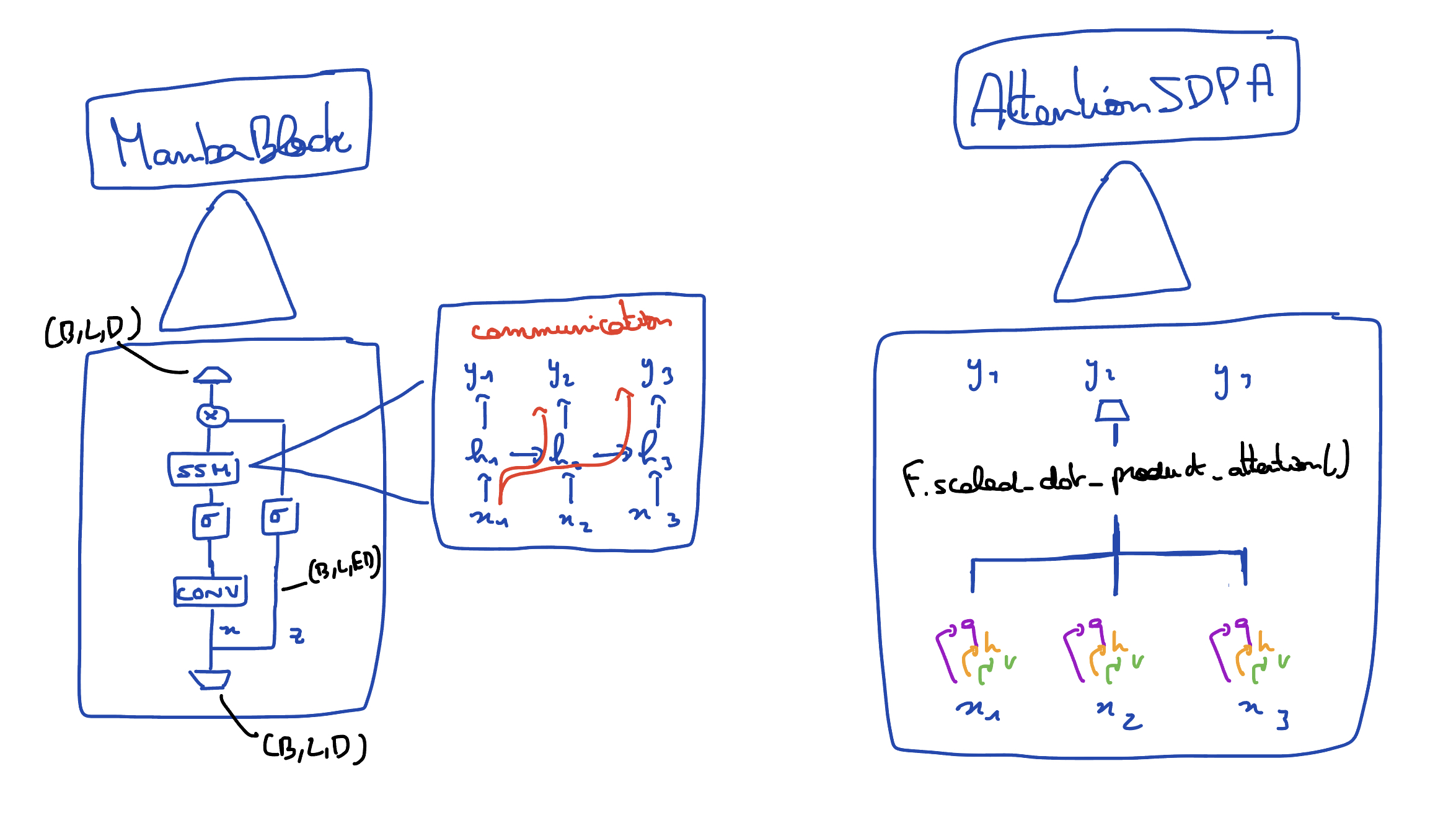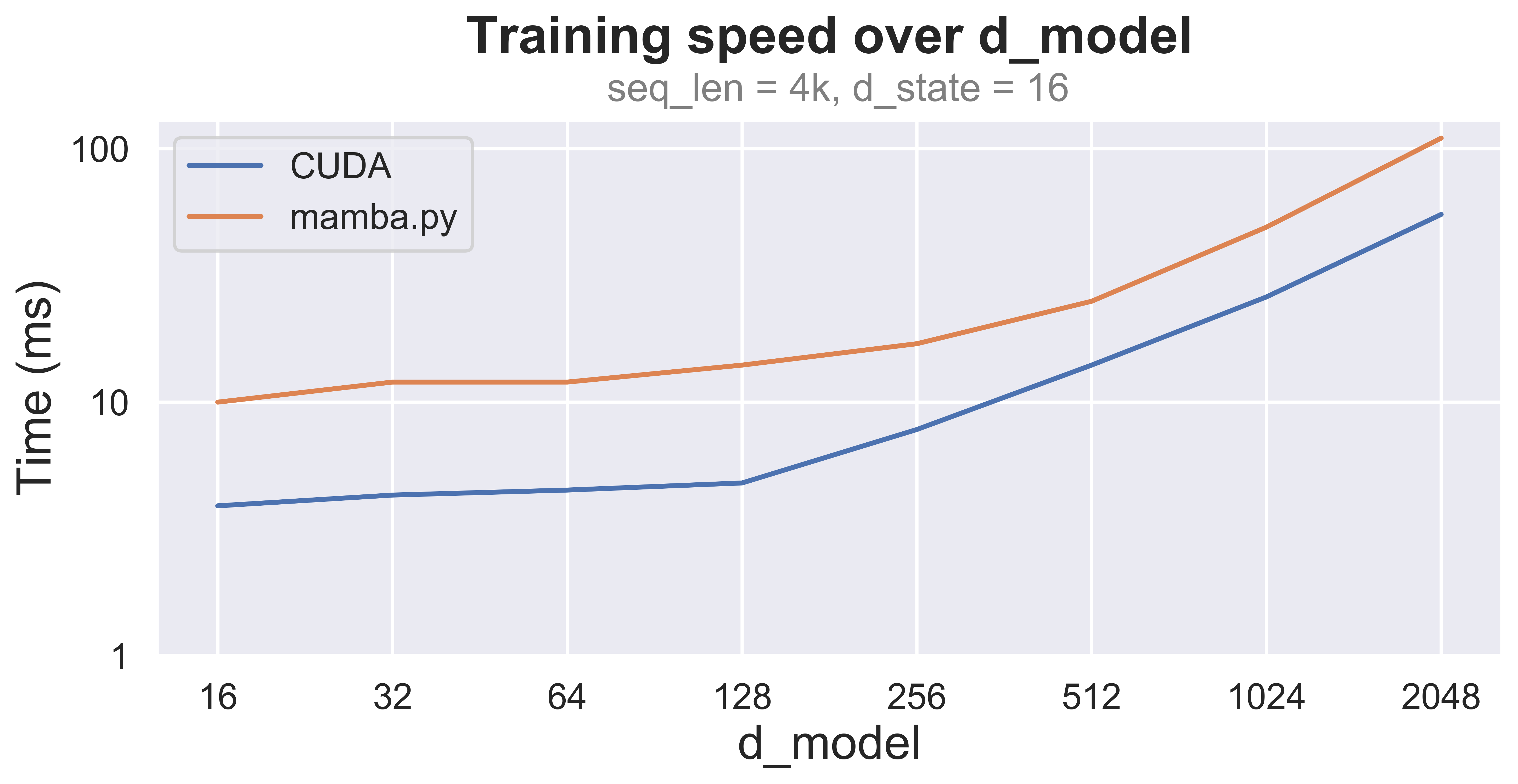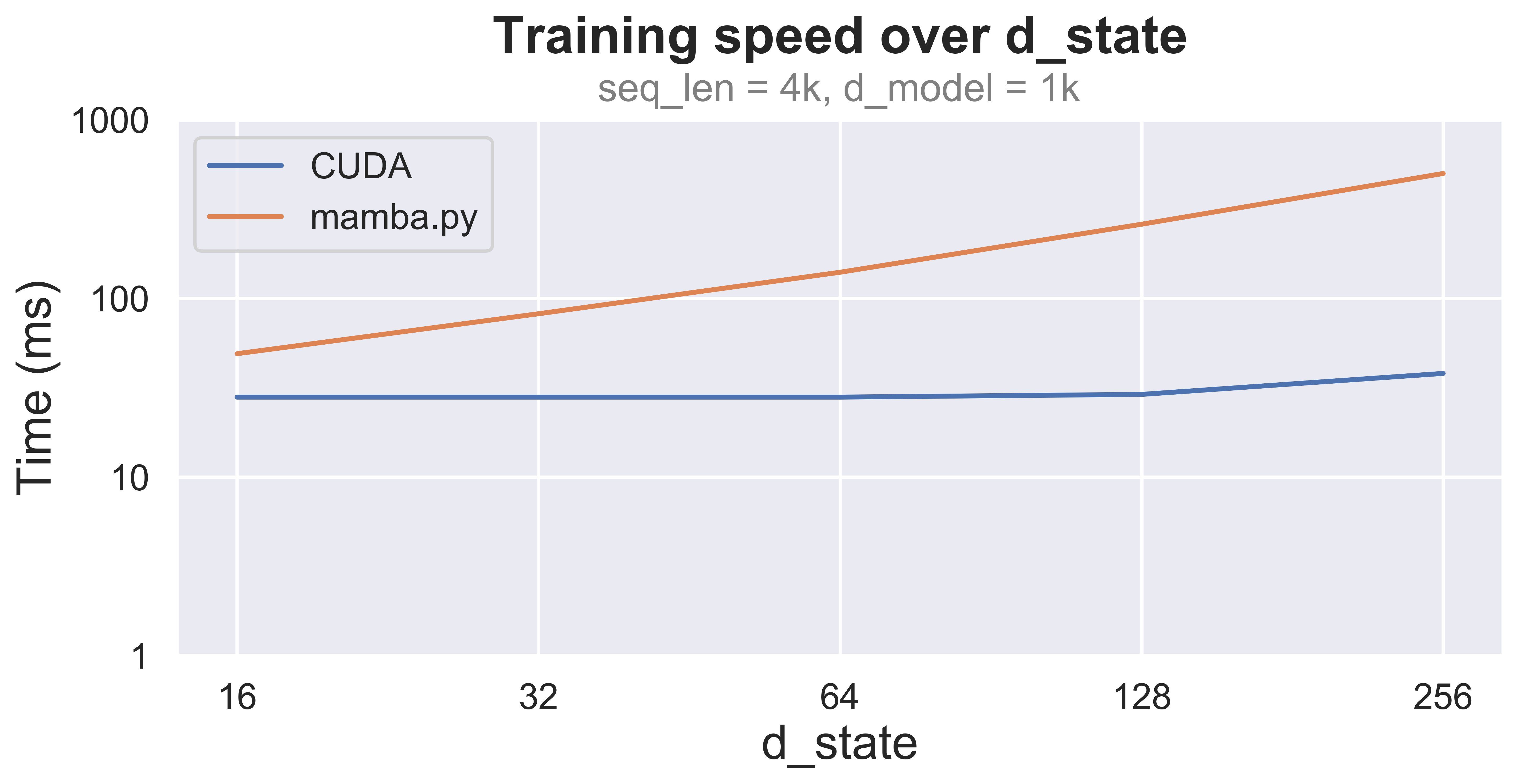A straightfoward implementation of Mamba in PyTorch with a simple parallel scan implementation, offering an major speedup over a sequential implementation, as the parallel scan allows the parallelization over the time dimension. It combines the ease of read with good performances when training. Jamba is also supported.
-
21/04/2024 : Added the
jamba.pyfile, which implements the Jamba architecture (mix of Mamba and attention layers). Also added as a possible backend the official CUDA implementation. -
30/03/2024 : Updated inference function, now supports sampling temperature and batch_size.
-
09/02/2024 : First part of the performance update. For small sequences (<128), it can speed up training by more than 20% compared to the first version. For setups close to what can found in practice (like in NLP), it can speed up training by 10%. See this.
-
22/01/2024 : Added a MLX version of
mamba.py, which supports inference as well as training. This version is similar to PyTorch, and allows Mac users to play around with Mamba models. It was tested on the largest Mamba trained to date (2.8b) -
17/01/2024 : Added a step function for inference. It uses the "RNN-formulation" of Mamba to greatly speed up inference.
This graph shows the training time (forward and backward pass) of a single Mamba layer (d_model=16, d_state=16) using 3 different methods : CUDA, which is the official Mamba implementation, mamba.py, which is this repo, and sequential, which is a sequential (RNN-like) implementation of the selective scan.
This repo contains a simple and readable code implementing the Mamba architecture in pure PyTorch as well as MLX. You can also play around with the Jamba model, which combines Mamba and attention layers. The primary goal of this repo is educational.
The repo is organized as follows :
pscan.py: a PyTorch implementation of Blelloch's parallel scanmamba.py: the Mamba model, as described in the paper. It is numerically equivalent (initialization, forward and backward pass).mamba_lm.py: encapsulates a Mamba model in order to use it as a language modeljamba.py: a clean implementation of the Jamba model in PyTorchvim.py: an implementation of Vision Mamba.📁 mlx: basically the same code as above, but in MLX.📁 docs: a folder containing annotated explanations about the code, focusing on the parallel scan📁 examples: two examples of how to use the Mamba model in PyTorch as well as a training file.
The most basic usage is to use the Mamba object (mamba.py), which implements a simple Mamba model given a configuration.
No embedding, no head : input is (B, L, D) and output is (B, L, D) as well.
import torch
from mamba import Mamba, MambaConfig
config = MambaConfig(d_model=16, n_layers=2)
model = Mamba(config)
B, L, D = 2, 64, 16
x = torch.randn(B, L, D)
y = model(x)
assert y.shape == x.shapeThe class MambaLM (mamba_lm.py) builds on the Mamba object and offers a classic API for language models. It can be used as follows :
from mamba_lm import MambaLM, MambaLMConfig
config = MambaLMConfig(d_model=16, n_layers=4, vocab_size=32000)
model = MambaLM(config)
x = torch.randint(high=32000, size=(16, 64))
logits = model(x) # (B, L, vocab_size)It simply encapsulates a Mamba object with an embedding layer, a final normalization and a language modeling head.
You can use it off the shelf with a pretrained Mamba model :
from mamba_lm import from_pretrained
from transformers import AutoTokenizer
model = from_pretrained('state-spaces/mamba-130m').to("cuda")
tokenizer = AutoTokenizer.from_pretrained('EleutherAI/gpt-neox-20b')
output = model.generate(tokenizer, "Mamba is a type of")This is the structure of the mamba.py modules:
You can also train and run inference on Jamba models. Take a look at the jamba.py file, which constructs a Jamba object, which interleaves Mamba layers (from mamba.py) with attention layers.
This is the structure of the modules found in jamba.py :
The API is the same as with the Mamba and MambaLM models.
You can load a pretrained Jamba model like so :
from jamba_lm import from_pretrained
from transformers import AutoTokenizer
model = from_pretrained('TechxGenus/Mini-Jamba').to("cuda")
tokenizer = AutoTokenizer.from_pretrained('TechxGenus/Mini-Jamba')
output = model.generate(tokenizer, "def min(arr):")There are two basics examples available :
example_llm.ipynb: load a Mamba model with pretrained weights (from 130M to 2.8B from HuggingFace)example_e2e_training.ipynb: an end-to-end training example where a Mamba model is employed as a world model for a simple 3-3 grid game (training is not completed, the model should be larger).
If you want a full training example (like in llama2.c), you can check the othello_mamba repo I've done. With this repo, you can train a Mamba or a Jamba from scratch, use bfloat16, easily swipe it with a Transformer, come up with your own data, etc ...
This section provides a more comprehensive performance comparison between mamba.py and the official Mamba implementation.
Overall, as the first graph of this file shows, both have approximately the same asymptotic performance with respect to the sequence length. You can think as mamba.py as a regular Transformer implementation, while the official Mamba implementation is more like FlashAttention v1. Both have their owns advantages.
That being said, does the two implementations have the same asymptotic performances with respect to the other parameters ?
We can see that both implementations behave the same as we increase d_model. The gap between the two stays roughly the same. (mamba.py is overall ~2x slower)
This graph is important. We see that here, the asymptotic performance is not the same as we increase d_state. For a reminder, d_state, or
Note : the CUDA version doesn't seem to be impacted by the increase of d_state. This is because the benchmark was done with a batch size of 1 : the GPU was not at its full capacity and thus the impact of an increased d_state isn't visible. The same happens if you have a small model, or a small input length. See this issue.
Does it matter in practice ? As of now, all the pretrained Mamba models (up to 2.8B parameters) used d_state=16, so this change of performance over d_state isn't important in this case. As d_state is not something that is supposed to grow (contrary to the seq length or d_model), this isn't a catastrophic result, but something to consider.
However, it is interesting to relate this observation with the claim made by Albert Gu and Tri Dao Mamba paper : The main idea is to leverage properties of modern accelerators (GPUs) to materialize the state ℎ only in more efficient levels of the memory hierarchy.
They also describe (Annex D) the main data movements of their selective scan : working mainly in SRAM, they can reduce the memory reads/writes by a factor of
With d_state=16 (as in state-spaces/mamba-2.8b-slimpj), the gap between the two is relatively small, but with d_state=64 (currently not used in any models), the gap widens. (note the OOM on the second graph)
All the previous graph were computed with a batch size of 1, on a A100 80GB. It is a measure of both the forward and backward pass of a single Mamba block.
The previous analysis showed the importance of kernel fusion, which reduces the memory accesses by
But memory requierement should also be considered : the official Mamba implementation uses recomputation in the backward pass : rather than keeping in memory the activations computed during the forward pass, it simply recomputes them in the backward pass, when needed. This greatly reduces the memory requierement of the Mamba model when doing training. This is not implemented in this repo.
Hence, this repo implements one of the three techniques mentionned in the Mamba paper that form the so called "hardware-aware selective scan" : the parallel scan. We say how kernel fusion impacts the speed while recomputation the memory requierements.
- the Mamba paper : describes the Mamba architecture as implemented in this repo, which allows to model sequences in linear time.
- the Mamba implementation, which is written in PyTorch but uses a parallel scan written in CUDA. This is the version that is the fastest.
- a minimal PyTorch implementation of Mamba, which implements the scan operation as a sequential loop (its performance are a bit worse than the 'sequential' line in the first graph). This code closely follows this file from the officile Mamba implementation, but replaces the CUDA convolution with
torch.nn.Conv1d, and the selective scan written in CUDA with a sequential loop. The code of this repo follows the structure of these 2 files. - Prefix Sums and Their Applications, by Guy E. Blelloch (1993).
- Parallelizing Linear Recurrent Neural Nets Over Sequence Length : applies a parallel scan over the sequence in order to get rid of the sequential for-loop.
- x.com/fchollet : original pscan implementation.
- pscan implementation using ThunderKittens ?
- following the performance update, update perf graph
- plot the training mem consumption of the three differents mamba imple (official, naive, mamba.py)
Jamba ? inference and/or fine-tuning ?- docs
more tests with an increasedd_model(add a Performances section)a step function, used for (auto-regressive) inference.a training function, similar to llama2.c
perfs related:
unfold the for-loops inpscan.pyto achieve better performance (see François Fleuret's pscan) (although this will sacrifice readability of bit)- write a reverse parallel scan specifically for the backward pass. (For now, we have to flip the array before and after the scan).- reduce the memory usage somehow (at the cost of speed if needed)
- use torch.compile(). As far as I tested, it doesn’t work for now. It seems it isn’t happy with the custom PScan autograd function. Need to investigate. (see PR#1)
